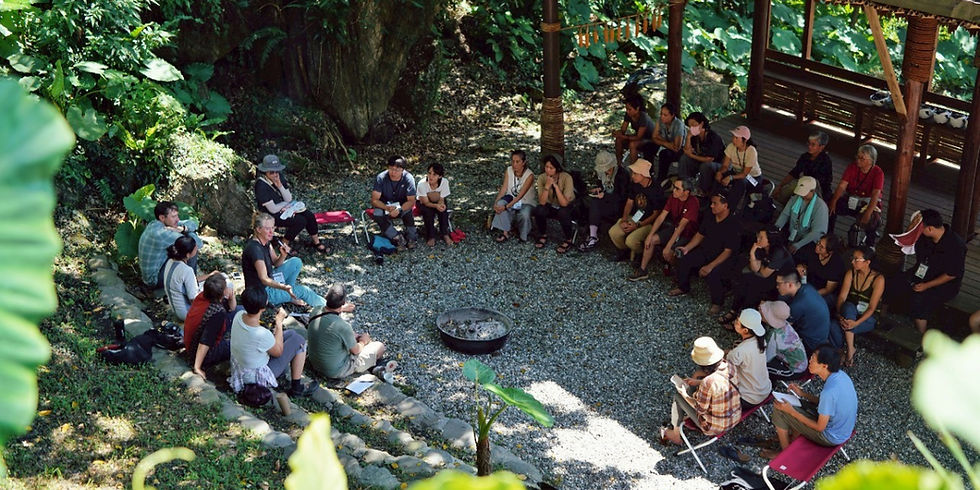Huatung Youths Return Home (Part 3)
- ACFI

- Jun 19, 2019
- 3 min read

With limited opportunity in the Huatung region, youths migrate to Taiwan’s west coast to find an alternative way to sustain their livelihood. In recent years, youths have been returning, bringing a diversity of talents home with them. This cover features the story of three young artists.

Lafin
Lafin, an Amis who spent much of his childhood and work-life in Taipei, remembers the summer and winter holidays spent at his native village in Changbin, Taitung catching fish, climbing areca palms. When he would feel lonely, these memories would come back to him like a calling.
Feeling uninspired in his profession, Lafin decided to move back to Taitung to the beautiful scene of the Pacific Ocean. He followed village elders to catch fish, to put into practice village traditions; and shadowed three native artists, learning wood carving and furniture making where he discovered a new direction and passion in life.
Lafin specialized in contemporary Taiwan aboriginal woodwork; and together with his wife, Heidi, they established an artist studio. With growing recognition, Lafin was invited to exhibit his works in Korea. The exhibition titled, Face, displayed raceless, genderless faces – his imagination where all are equal. The door of Chishang’s gallery, another creation of Lafin, demonstrates his artistic style. The work was inspired by the Pacific Ocean waves, and rice – a main staple of his people, depicting subtle elements of Huatung and his native culture rather than clear traditional native patterns and emblems.

Lafin’s work often gives tribute to the environment, and gives voice to environmental issues. His work named Black Hair Bridge is a villager with darkened wet hair, inspired by a Kararuan villager’s common practice of washing dust off their bodies at the riverbank before their return home. It also faces the Dulan Mountain, a mountain worshiped by the Amis. Through time the driftwood piece will eventually deteriorate and return to nature. Many youths hesitate before moving back to Huatung due to a lack of opportunity, but Lafin believes, if one has the will, one will find a way. Today, Lafin’s works are collected globally.

Heidi Yip A painter born in Hong Kong and raised in Canada, before moving to Taitung, Heidi, studied in Florence and worked in New York. When she was young, she enjoyed the works of Taiwanese film directors Hou Hsiao-Hsien and Edward Yang, which brought her to visit the island where many of the scenes were filmed. In her visits, she was particularly drawn to Taitung even before meeting husband, Lafin. While she was in Taitung, she would follow the native women to gather seaweeds and shellfish, learning to observe when to harvest them from the tide. Through the experience, she learned that nature gives us the answer when we look for them.

In the 1960s and 1970s, many would travel to the Taitung mountains to search for Sapphire; she created the “Ore Series” in inspiration of it. Heidi’s style of painting while she was in New York was abstract; the majority of her works today are relating to nature showing the colours of Taitung, its tropical warmth and humidity.
In their effort to preserve tradition, Heidi and Lafin’s child attends Amis school. They hope their child will be able to use the Amis language to learn about the world.

Sumi Dongi Sumi Dongi, after years of working in Taipei in a café, in insurance and retail, she returned home to the Makotaay Village in search for healing from her failed relationship and career. She found a new appreciation for her home and found the courage and understanding that the sky is the limit.
Through hard work, she discovered her strengths. She was able to revive an abandoned rice patty field in hopes to preserve the land for her people, preventing it from being sold. In reviving the field, villagers are able to protect the land, its beautiful landscape, animals, plants and to make a living from its crops.

Contrary to her experience in Taipei, she felt that anything she pursued in Taitung became a success. She realized her artistry talents when she discovered the umbrella sedge – a waivable grass harvested every July and August. Villagers often wove bed and chair mats to keep cool in the summers; some will even drape it over their backs. Sumi takes the material and weaves it into delicate handicrafts, lamps, and curtains. Her works are globally appreciated and featured on the international Kamaro’an platform.
Sumi also organizes the Mipaliw Land Art – an Artist-in-Residence program taking place between the months of August and March. During this time period, artists worldwide are invited to live and create art in the village for one month at a time.
Sumi has never called herself an artist. She feels that art is a part of her living, and that she is constantly present in her living.





Comments